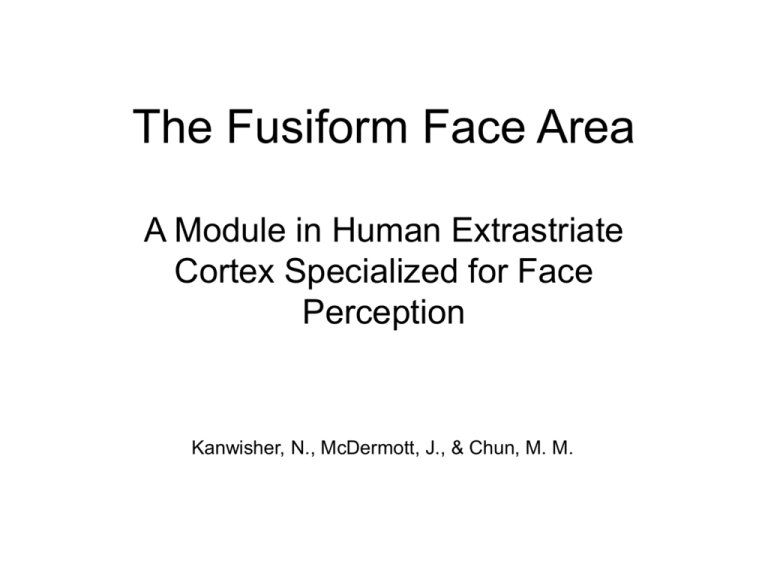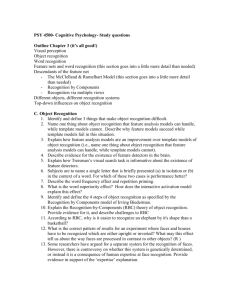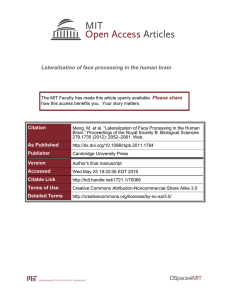The Fusiform Face Area
advertisement

The Fusiform Face Area A Module in Human Extrastriate Cortex Specialized for Face Perception Kanwisher, N., McDermott, J., & Chun, M. M. Is Face Recognition Special? • Evidence from cognitive psych – Inverted faces are disproportionately more difficult to recognise than other inverted objects (Yin, 1969) – Memory for precise configurations of facial features better than for houses (Bruce et al., 1991) – Advantage for face part recognition in context of whole face over part in isolation larger than for house parts (Tanaka & Farah, 1993) • If face recognition is special, might have a dedicated region of cortex: – Neurons in superior temporal sulcus (STS) of macaques fire selectively to faces – Large N200 ERPs evoked in response to faces, but not to other objects, in portions of fusiform and inferotemporal gyri – Patients with damage to occipitotemporal region of the RH are sometimes prosopagnosic (De Renzi, 1997) Evidence from Imaging • fusiform gyrus more active during: – face recognition than during recognition of other objects (Sergent et al.,1992) – matching faces than matching locations (Haxby et al., 1991, 1994; Courtney et al., 1997) – viewing of faces than during viewing of scrambled faces (Puce et al., 1995; Clark et al., 1996), consonant strings (Puce et al., 1996), or textures (Malach et al., 1995; Puce et al., 1996) Why another imaging study? • Although the evidence for fusiform involvement in face recognition is considerable, unclear whether fusiform responds selectively to faces • Alternative hypotheses: – fusiform lights up because of involvement in: • low-level feature extraction • allocation of attention to faces due to a general attentional bias towards faces • subordinate level recognition of category exemplars • recognition of any animate (or perhaps only human) objects • The authors hoped to rule out these four alternative hypotheses General Design • Part I: looked for a region of interest (ROI) on a subject-by-subject basis that is reliably more responsive to faces than to objects • Part II: tested low-level feature hypothesis and exemplar differentiation hypothesis • Part III: tested whether ROI would respond to: – faces viewed at an angle – faces in which external features (e.g., hair) were concealed – human hands, and – faces when attentional resources are limited by performing a concurrent task Technical Stuff • In each run, twelve 6 mm slices were taken at once, 160 times, at a rate of 1 every 2 seconds • Slices covered all of the occipital and most of the temporal lobes • Voxel size: 3.25 X 3.25 X 6 mm • Data analysis assumed a hemodynamic response lag of 6 seconds • For each subject, both anatomical and functional data were fit to their own Talairach co-ordinates Part I • Six 30 sec stimulus epochs were interleaved with seven 20 sec fixation epochs • 45 different photos, presented at a rate of 1 every 670 ms (stimulus on for 500 ms, off for 170 ms) • Stimulus set consisted of 180 unique photos: – 90 photos of students – 90 photos of objects • First and sixth stimulus epochs consisted of the same set of photos, as did the second and seventh • Subjects were instructed to maintain fixation during non-stimulus epochs and (in stimulus epochs) to simply look at the stimuli “without carrying out other mental games at the same time” Part I Results • Voxels in which the MR signal was significantly larger with passive viewing of faces than of objects (p < 0.001) were identified • Only region showing reliably greater activation for faces was right fusiform gyrus • 12/15 SJs showed fusiform activation (half in nondominant hemisphere only, half in both hemispheres) – bilateral parahippocampal activation in response to objects constitutes a double dissociation • 2.6% signal change for faces, 0.95% signal change for objects • 2.74:1 ratio of signal change for face:object epochs • This “scouting,” done separately for each subject, allowed the researchers to identify areas within each subject that should light up specifically in response to faces, in Parts II and III Part II, Comparison 1: Low-level feature hypothesis • Maybe fusiform is involved in any type of lowlevel feature extraction • 5 of the 10 subjects from Part I showing clear RH fusiform activation participated in Part II • Presented two-tone versions of photographs shown in Part I and scrambled versions of the same photographs using Procedure from Part I • Scrambling preserves average luminance of intact faces and other low-level features Results • 1.9% signal change from baseline during intact face epochs (identical to the change for this subset of SJs in Part I) • 0.6% signal change during scrambled face epochs, difference was reliable, p < 0.05 • 3.2:1 intact:scrambled ratio Part II, Comparison 2: Exemplar Hypothesis • Maybe fusiform responds to exemplars within categories of objects – Faces in first comparison were exemplars of a particular category (i.e., faces!) but the objects shown did not belong to any one category • Procedure identical to that used in previous comparison – exception: houses used in place of scrambled faces • Subjects were same five who participated in the intact vs. scrambled faces test Results • 1.6% signal change for faces, 0.2% signal change for houses, p < 0.01 • Ratio 6.6:1 faces:houses • Fusiform activation cannot be attributed to presentation of category exemplars Part III, Comparison 1: Passive Viewing of ¾ Faces vs. Hands (full attention) • Perhaps fusiform responds to canonical faces, or to features external to faces but normally present in photos (e.g., hair) • Also possible that ROI responds to any animate thing or to any body part • Broad sweep: Used ¾ faces with hair hidden in one condition and pictures of hands in the comparison condition Results • 2.7% signal change for faces, 0.7% signal change for hands, p < 0.02 • 4.0:1 faces:hands ratio • Fusiform responds to ¾ view faces, even when hair is concealed • Additionally, fusiform responds much more strongly to such faces than to hands Part III, Comparison 2 Passive Viewing ¾ Faces vs Hands (divided attention) • Repeated procedure from previous comparison, but subjects now had to perform a 1-back task with stimuli rather than passively view them • Task was to respond whenever a repetition in the stimulus sequence was detected (i.e., when stimulus n and stimulus n-1 were identical) • Purpose was to determine whether fusiform responds not to faces selectively, but to anything that engages general attentional resources • If this is so, allocating attention to a concurrent task should reduce resources available for attending to faces, reducing fusiform activation • Might get a main effect (less activation for both faces and hands), but critical finding would be that activation for faces = activation for hands Results • 3.2% signal change for faces, 0.7% signal change for hands, p < .005 • 4.5:1 faces:hands ratio • Reducing available attentional resources did not reduce fusiform activation • Same task run in lab showed that the task is easier with faces (92% accurate) than with hands (86% accurate) suggesting that the task with hands engaged attention at least as much as it did with faces • These data also rule out idea that fusiform fires whenever subordinate-level classification is required – 1 back task with both faces and hands required subordinate level classification to be able to match the stimuli on trials n and n-1 Discussion • Evidence that fusiform fires specifically to faces – May be other areas involved as well – some subjects showed activation in medial temporal gyrus and in superior temporal sulcus • Fusiform does not fire in response to: – Low level features of faces in scrambled face stimuli – All category exemplars – All animate or human items – General recruitment of attention by stimuli • Authors note that their finding of several subjects with bilateral fusiform activation explains why posterior RH damage often, but not always, produces prosopagnosia • Patient data show double dissociations between: – Ability to identify faces and extract emotional expression from them – Ability to identify faces and discriminate gaze direction • These findings suggest that there may be regions of cortex specialised for functions involved in face processing • Possible that face processing is more “holistic” than processing of other objects – maybe fusiform is needed for global processing • Test by inducing local face processing – Might not resolve issue because a part of a face (e.g., nose) is not actually a face • if subjects can process noses to the exclusion of the rest of the face and fusiform is responsible for face processing, not surprising if it doesn’t fire









